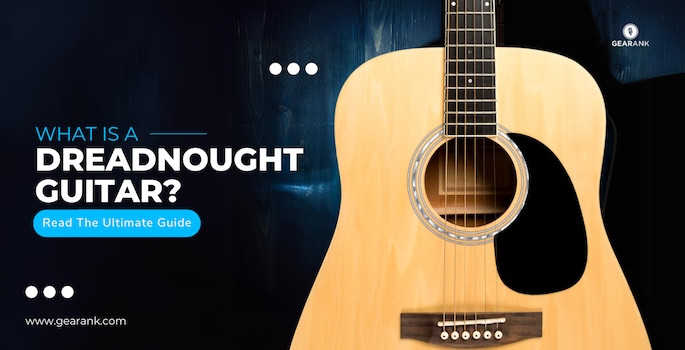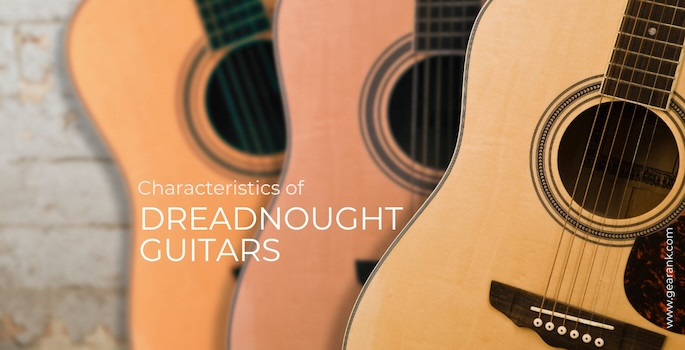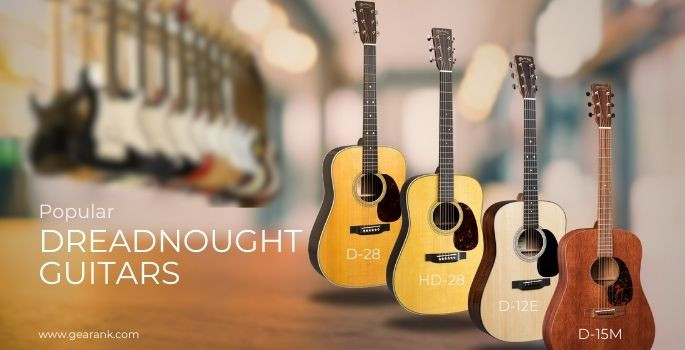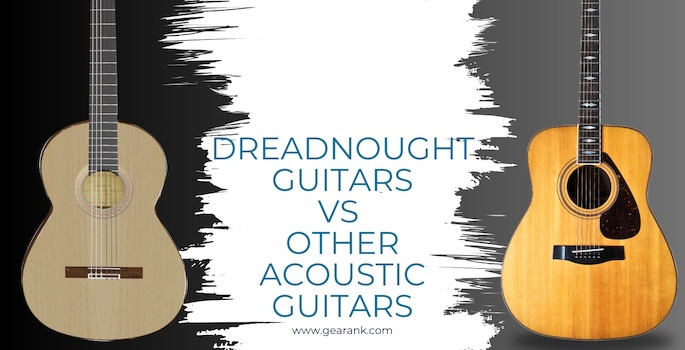 Close-up of a dreadnought acoustic guitar body, highlighting its iconic shape.
Close-up of a dreadnought acoustic guitar body, highlighting its iconic shape.
When you picture an acoustic guitar, chances are you’re envisioning a dreadnought. This iconic body shape dominates the acoustic guitar landscape, favored by countless musicians across genres. Renowned for its powerful sound and versatile nature, the dreadnought has earned its place as the most popular acoustic guitar shape worldwide.
But what exactly defines a dreadnought? What sets it apart from other acoustic guitars, and why has it become the go-to choice for so many players? In this comprehensive guide, we’ll delve into the world of dreadnought guitars, exploring their history, characteristics, and why they might be the perfect fit for your musical journey.
Unpacking the Dreadnought: Origins and Evolution
The name “dreadnought” might sound imposing, and it’s no coincidence. It originates from the HMS Dreadnought, a revolutionary British battleship launched in the early 20th century. At the time, it was the largest and most powerful warship, and C.F. Martin, the pioneering guitar manufacturer, sought to capture that sense of size and power when they developed this new guitar body shape.
Initially conceived in 1916, the dreadnought guitar was a collaboration between C.F. Martin & Company and the Oliver Ditson retail corporation. The original models, however, didn’t achieve immediate success and were discontinued. It wasn’t until 1931, with a design revision and Martin branding, that the dreadnought truly took off. Crafted from rosewood and mahogany, these Martin dreadnoughts quickly gained traction, particularly among folk and bluegrass musicians. Their signature loud voice and balanced tonal qualities resonated perfectly with these genres.
The booming popularity of the dreadnought didn’t go unnoticed. Gibson, a major competitor, responded by creating their own large-bodied acoustic, the round-shouldered Jumbo. Other manufacturers followed suit, further solidifying the dreadnought as a dominant force in the acoustic guitar market. Its traditional design features square shoulders and straight lines along the upper and lower body, creating a larger sound chamber compared to many other shapes. This increased volume and richer, deeper tone are key reasons why the dreadnought remains the most sought-after acoustic guitar body type today.
Delving into Dreadnought Guitar Characteristics
 Infographic illustrating the key characteristics of dreadnought guitars, including dimensions and sound profile.
Infographic illustrating the key characteristics of dreadnought guitars, including dimensions and sound profile.
Dreadnought guitars are celebrated for their robust and resonant sound. They deliver a strong mid-range presence coupled with significant volume, making them incredibly versatile and appealing to a wide range of players. Their reliability and powerful sound projection have made them a staple instrument for musicians across genres.
One of the defining characteristics of a dreadnought is its ability to produce a loud and full tone. This sonic power stems directly from its size and body construction. Dreadnoughts excel in percussive playing styles, flatpicking, and strumming, making them ideal rhythm instruments in acoustic bands or powerful accompaniment for vocalists.
While dimensions can vary slightly between manufacturers, the “standard” dreadnought size is generally based on Martin’s specifications. These dimensions provide a guideline for what to expect from a typical dreadnought body:
| Dimension | Measurement |
|---|---|
| Body Length | 20 inches |
| Upper Bout Width | 11.5 inches |
| Lower Bout Width | 15.625 inches |
| Upper Bout Depth | 3.94 inches |
| Lower Bout Depth | 4.875 inches |
Playability and Sonic Versatility
Dreadnoughts are popular among acoustic guitarists due to their versatility across musical contexts. Whether playing solo, in a band, or accompanying singers, they fit seamlessly into diverse musical landscapes. They also accommodate various playing techniques, from aggressive strumming and flatpicking to delicate fingerstyle arrangements.
Sonically, dreadnoughts are known for their pronounced volume and balanced tone. The well-defined mid-range complements a strong bass response, making them a favorite for singer-songwriters who need a guitar that can both support vocals and stand out in a mix.
Physical Build and Design
The dreadnought’s body shape is characterized by a broader waistline, resulting in a more squared-off appearance compared to guitars with rounder, more defined waists.
Traditionally, dreadnought guitars feature a solid spruce top, prized for its responsiveness and clarity, combined with mahogany back and sides, known for warmth and sustain. However, tonewood choices can vary depending on the specific model and manufacturer, influencing the guitar’s tonal character.
The neck of a dreadnought guitar typically joins the body at the 14th fret. This design provides comfortable access to higher notes on the fretboard, facilitating a wider range of chord voicings and melodic possibilities.
Popular Dreadnought Guitar Models and Iconic Players
 Collage of popular dreadnought guitar models, showcasing different brands and styles.
Collage of popular dreadnought guitar models, showcasing different brands and styles.
When discussing dreadnought guitars, the Martin D-28 immediately comes to mind. This model is legendary, famously associated with folk icon Johnny Cash, who reportedly used two D-28s throughout the last three decades of his career.
Martin continues to produce a diverse range of dreadnought models catering to different budgets and preferences, including the HD-28, Martin D-12E, and D-15M. Martin guitars are widely regarded as high-quality instruments, known for their exceptional craftsmanship and premium tonewoods. High-end Martin dreadnoughts often feature rosewood for the bridge, fretboard, back, and sides, further enhancing their tonal richness and complexity.
For players seeking more budget-friendly options, excellent alternatives are available. Models like the Fender CD-60S and Yamaha FG800 offer the dreadnought experience at a more accessible price point, providing great value and quality.
The list of notable musicians who have embraced dreadnought guitars is extensive and impressive. Guitar legends like Eric Clapton and Kurt Cobain, among many others, have utilized dreadnoughts in both studio recordings and live performances, solidifying its place as a cornerstone of acoustic music.
Dreadnought Guitar vs. Exploring Other Acoustic Body Shapes
 Comparison chart of dreadnought guitars against other acoustic guitar body shapes, highlighting differences in shape and sound.
Comparison chart of dreadnought guitars against other acoustic guitar body shapes, highlighting differences in shape and sound.
The dreadnought’s broad body and less pronounced waist are visually distinctive features that have inspired countless acoustic guitar designs. Its shape is a major factor in its resonant and powerful sound. But how does the dreadnought compare to other popular acoustic guitar body shapes? Let’s explore some key differences:
-
Classical Guitars vs. Dreadnought Guitars: Classical guitars have a smaller body compared to dreadnoughts, resulting in a more balanced sound with a focused mid-range. Dreadnoughts, in contrast, deliver a louder tone, deeper bass, and crisper treble. Another crucial difference lies in the strings: classical guitars use nylon strings, while dreadnoughts are strung with steel strings, contributing significantly to their distinct sounds and playing styles.
-
Concert Guitars vs. Dreadnought Guitars: Concert guitars feature a slimmer waist than dreadnoughts. Sonically, while dreadnoughts excel in ensemble settings, concert guitars are often favored for solo performances. They offer a more concentrated and focused sound, ideal for intimate settings and nuanced playing.
-
Grand Auditorium Guitars vs. Dreadnought Guitars: Dreadnoughts are primarily favored for strumming due to their deep, bass-rich tone. Grand auditorium guitars, with their smaller waist and rounder shape, are often preferred for fingerstyle playing. They offer a balanced tone that suits intricate fingerpicking patterns.
-
Jumbo Guitars vs. Dreadnought Guitars: Jumbo guitars, in contrast to the dreadnought’s squarer shape, have a rounder and larger body. This results in an even stronger bass response compared to dreadnoughts. Jumbo guitars are known for their rich, resonant notes, making them well-suited for genres like blues, jazz, and even rock.
-
Parlor Guitars vs. Dreadnought Guitars: Parlor guitars are significantly smaller and more compact than dreadnoughts, making them highly portable and easy to handle. They also produce a gentler, more mellow tone, contrasting with the dreadnought’s robust sound. This makes parlor guitars a great choice for blues and fingerpicking styles where a more intimate and controlled tone is desired.
Is a Dreadnought Guitar Right For You and Your Playing Style?
 Musician playing a dreadnought acoustic guitar, suggesting its suitability for various playing styles.
Musician playing a dreadnought acoustic guitar, suggesting its suitability for various playing styles.
If you’re in the market for a new acoustic guitar and wondering if a dreadnought is the right choice for your playing style, consider your sonic preferences and physical comfort.
If you’re drawn to a bold, rich tone and enjoy strumming or fingerstyle techniques, you’ll likely appreciate the dreadnought’s sonic capabilities. Its powerful sound is well-suited for singer-songwriters and acoustic bands seeking a guitar with strong projection and presence.
However, be mindful of its larger size and deeper body. These dimensions can sometimes pose a challenge for players with smaller frames or those who prefer a more compact instrument.
Ultimately, choosing a dreadnought, like any guitar, comes down to personal preference. Dreadnought guitars offer remarkable tonal and projection versatility, making them adaptable to a wide spectrum of musical styles and playing approaches.
Final Thoughts on the Dreadnought Guitar
The dreadnought guitar body shape has undeniably left an indelible mark on the world of acoustic guitars, inspiring generations of instruments and players.
Initially conceived by C.F. Martin & Company in 1916, the dreadnought’s enduring popularity is a testament to its timeless design and sonic appeal. It continues to serve a vast range of musical needs and player preferences, from beginners to seasoned professionals.
If you’re seeking a reliable, versatile acoustic guitar with excellent projection and a powerful voice, the dreadnought shape should undoubtedly be at the top of your list. It’s a true workhorse instrument that has earned its place as a cornerstone of acoustic music.
Frequently Asked Questions
Is a Dreadnought Guitar Good for Beginners?
Dreadnought guitars, due to their larger body size, can present some initial challenges for beginner guitar players, particularly children or individuals with smaller frames. The bulkier shape might feel awkward at first, but with practice, most students adapt to it. Some younger learners even start directly with dreadnoughts without significant issues. A popular beginner-friendly option is the Fender CD-60SCE dreadnought, which features rolled fingerboard edges and a cutaway for enhanced playability.
However, if comfort is a primary concern, or if you’re encouraging a hesitant student, smaller-bodied acoustics might be a better starting point. Downsized ¾ scale dreadnought acoustic guitars are specifically designed for children, offering a more manageable playing experience.
Is My Acoustic Guitar a Dreadnought?
One of the most distinguishing features of a dreadnought acoustic guitar is its size and shape. Look for a large body with a wide lower bout, square shoulders, and a less defined waist. Typically, the neck joint on a dreadnought guitar is located at the 14th fret.
Can I Plug My Dreadnought Acoustic Guitar Into a Speaker?
Yes, if your dreadnought is an electro-acoustic model. Many modern dreadnought guitars are available as acoustic-electric versions, equipped with built-in pickup and preamp systems. This allows you to connect them to an amplifier or speaker system.
Advanced acoustic-electric dreadnoughts may include preamps with features like tuners, volume controls, and tone-shaping options. A cutaway near the neck is often a visual cue indicating that a dreadnought is an acoustic-electric model.
Contributors:
Jerome Arcon – Co-writer
Jerry Borillo – Illustrator
More Acoustic Guitars & Gear
The Best Acoustic Guitars For Beginners
Things To Consider When Buying An Acoustic Guitar
The Best Acoustic Guitars Under $1000
[
